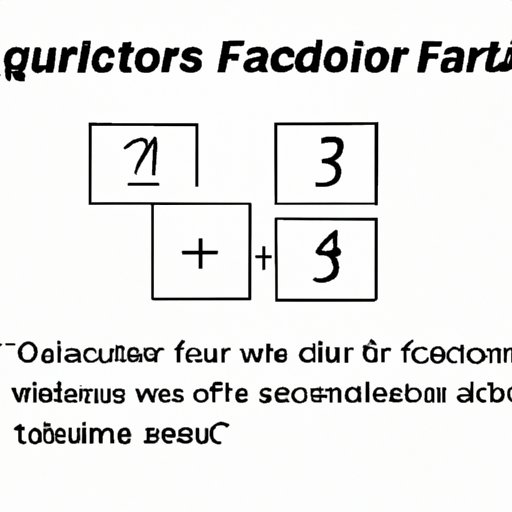
I. Introduction
Quadratics are a fundamental concept in algebra, used to solve problems and model real-world scenarios. Factoring quadratics, or breaking them down into simpler expressions, is a key skill for success in high school and college math. In this article, we will explore step-by-step guides, tips, and tricks for factoring quadratics. Whether you’re a beginner or advanced math student, there’s something in this guide for you!
II. Solving Quadratics Made Easy: A Step-by-Step Guide to Factoring Them
Factoring is the process of breaking down a quadratic equation into its simpler components. It is an essential skill for solving complex algebraic problems. Here is a step-by-step guide to factoring a quadratic equation:
- Write the quadratic equation in standard form: ax^2 + bx + c = 0
- Multiply a and c together, then find two numbers that multiply to equal ac and add to equal b, the middle term.
- Use the two numbers from step 2 to rewrite the middle term, bx, as the sum or difference of two terms (in other words, factor by grouping)
- Factor out the common factor of the first two terms and the common factor of the last two terms
- Set each factor equal to zero and solve for x
Let’s look at an example:
Factor x^2 + 2x – 15 = 0
- Standard form: x^2 + 2x – 15 = 0
- Multiply a and c: 1 * -15 = -15. Find two numbers that multiply to -15 and add to 2: 5 and -3.
- Rewrite middle term: x^2 + 5x – 3x – 15 = 0
- Factor by grouping: (x^2 + 5x) – (3x + 15) = 0; x(x+5) – 3(x+5) = 0
- Factor out common factor: (x+5)(x-3) = 0
- Set each factor equal to zero: x+5=0 or x-3=0
- Solve for x: x=-5 or x=3
So the factors of x^2 + 2x – 15 are (x+5)(x-3).
III. The Ultimate Guide to Factoring Quadratics for Beginners
There are several methods for factoring quadratic equations, each with its own pros and cons. Let’s explore them:
- Factoring by grouping: This is the most straightforward method for factoring quadratics. It involves breaking the quadratic equation into two parts and then grouping terms that have common factors. This is especially useful when there are four terms in the equation.
- Factoring by trial and error: This method involves guessing factors until you find one that works. It can be time-consuming, but it’s a good option when there are three terms in the equation.
- Factoring using the quadratic formula: This method involves applying the quadratic formula to the quadratic equation. It can be used for any quadratic equation, but it can be difficult to memorize the formula.
Let’s look at examples of each method:
Factoring by grouping: Factor 2x^3 – x^2 – 4x + 2
- Group the first two terms: x^2(2x – 1)
- Group the last two terms: -2(2x – 1)
- The factors are (2x – 1) and (x^2 – 2).
Factoring by trial and error: Factor x^3 – 2x^2 – x + 2
- List the possible factors of 2 (the constant): 1*2 or 2*1
- Test each combination to see which works: (x-1) and (x^2 – x – 2) are the factors.
Factoring using the quadratic formula: Factor 3x^2 – 4x + 1
- Apply the quadratic formula: x = (-b ± √(b^2 – 4ac))/2a
- Plug in the coefficients from the equation: x = (4 ± √(16 – 12))/6
- The factors are (3x-1)(x-1).
Each method has its own advantages and disadvantages, but with practice, you’ll be able to decide which method works best for each equation.
IV. From FOIL Method to Factoring: Simplifying Quadratics in Simple Steps
The FOIL method (first, outer, inner, last) is a helpful mnemonic for multiplying two binomials. It can also be used in reverse to factor a quadratic equation. Here’s how:
Solve 2x^2 + x – 3 = 0 using FOIL.
- Identify the two binomials: 2x^2 can be factored as (2x)(x)
- Identify what the two factors might be: (ax + ?) and (bx + ?)
- Multiply the first and last terms: 2x * -3 = -6x
- Find factors of -6 that add up to b (in this case, b=1): -6 and 1
- Write the factored form: (2x – 1)(x + 3)
The FOIL method is a helpful tool for factoring quadratics, especially when there are two terms in the equation.
V. How to Factor Quadratics: Tips and Tricks from Math Experts
Math experts have many tips and tricks for factoring quadratics. Here are some of their best:
- Use graphing calculators to check your work.
- Practice, practice, practice!
- Factor out the greatest common factor first.
- Make sure you write the factors in the correct order.
- Memorize perfect squares and cubes for faster factoring.
These tips will help you feel more confident and efficient when factoring quadratics.
VI. Factoring Quadratics Demystified: Simple Strategies for Easy Solutions
Factoring quadratics can seem like a daunting task, but there are simple strategies that can help make it easier. Here are a few:
- Start by factoring out the greatest common factor.
- Take advantage of symmetry in quadratic equations.
- Focus on the middle term when identifying factors.
- Look for patterns.
By following these strategies, you can simplify the factoring process and arrive at solutions more quickly.
VII. Mastering Quadratics: A Comprehensive Guide to Factoring Equations
Factoring quadratics is a complex skill that requires practice and patience. Here’s a comprehensive guide to mastering it:
- Learn the basics of factoring, including the FOIL method.
- Familiarize yourself with the different methods for factoring quadratics.
- Practice different types of quadratic equations using each method.
- Memorize perfect squares and cubes to simplify factoring.
- Identify patterns in quadratic equations.
- Practice, practice, practice!
By following these steps, you can become a master of factoring quadratics.

VIII. Factoring Quadratics: How to Identify Patterns and Simplify Your Work
Identifying patterns in quadratic equations can simplify the factoring process. Here are some common patterns:
- Square of a binomial: (a+b)^2 = a^2 + 2ab + b^2
- Difference of squares: (a-b)(a+b) = a^2 – b^2
- Perfect square trinomials: a^2 ± 2ab + b^2 = (a ± b)^2
By recognizing these patterns, you can factor quadratics more easily and quickly.
IX. Conclusion
Factoring quadratics is an essential skill for success in algebra and beyond. By mastering different methods and strategies for factoring, you’ll be able to solve complex mathematical problems and model real-world scenarios. Remember to practice diligently and take advantage of tips and tricks from math experts.




